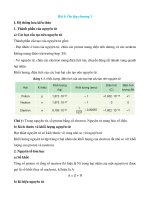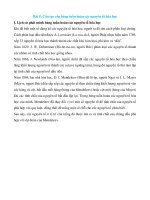PHUONG PHAP THUYET TRINH BANG TIENG ANH
Bạn đang xem bản rút gọn của tài liệu. Xem và tải ngay bản đầy đủ của tài liệu tại đây (44.09 KB, 5 trang )
<span class='text_page_counter'>(1)</span>Overviews After you give your opening statement, you should give a brief overview of your presentation. This includes what your presentation is about, how long you will take and how you are going to handle questions. For example, a presentation to sales staff could start like this: "Welcome / "Hello everyone." Opening statement "As you all know, this company is losing its market share. But we are being asked to increase sales by 20 – 25%. How can we possibly increase sales in a shrinking market?" Overview "Today I am going to talk to you about how we can do this. My presentation will be in three parts. Firstly I am going to look at the market and the background. Then I am going to talk to you about our new products and how they fit in. Finally, I'm going to examine some selling strategies that will help us increase our sales by 20%. The presentation will probably take around 20 minutes. There will be time for questions at the end of my talk." Useful language for overviews "My presentation is in three parts." "My presentation is divided into three main sections." "Firstly, secondly, thirdly, finally…" "I'm going to… take a look at… talk about… examine… tell you something about the background… give you some facts and figures… fill you in on the history of… concentrate on… limit myself to the question of… "Please feel free to interrupt me if you have questions." "There will be time for questions at the end of the presentation.".
<span class='text_page_counter'>(2)</span> "I'd be grateful if you could ask your questions after the presentation." The main body of the presentation. During your presentation, it’s a good idea to remind your audience occasionally of the benefit of what you are saying. "As I said at the beginning…" "This, of course, will help you (to achieve the 20% increase)." "As you remember, we are concerned with…" "This ties in with my original statement…" "This relates directly to the question I put to you before…" Keeping your audience with you Remember that what you are saying is new to your audience. You are clear about the structure of your talk, but let your audience know when you are moving on to a new point. You can do this by saying something like "right", or "OK". You can also use some of the following expressions: "I'd now like to move on to…" "I'd like to turn to…" "That's all I have to say about…" "Now I'd like to look at…" "This leads me to my next point…" If you are using index cards, putting the link on the cards will help you remember to keep the audience with you. In addition, by glancing at your index cards you will be pausing - this will also help your audience to realise that you are moving on to something new. Language for using visuals It's important to introduce your visual to the audience. You can use the following phrases: "This graph shows you…" "Take a look at this…" "If you look at this, you will see…".
<span class='text_page_counter'>(3)</span> "I'd like you to look at this…" "This chart illustrates the figures…" "This graph gives you a break down of…" Give your audience enough time to absorb the information on the visual. Pause to allow them to look at the information and then explain why the visual is important: "As you can see…" "This clearly shows …" "From this, we can understand how / why…" "This area of the chart is interesting…". Summarizing At the end of your presentation, you should summarise your talk and remind the audience of what you have told them: "That brings me to the end of my presentation. I've talked about…" "Well, that's about it for now. We've covered…" "So, that was our marketing strategy. In brief, we…" "To summarize, I…" Relate the end of your presentation to your opening statement:. "So I hope that you're a little clearer on how we can achieve sales growth of 20%." "To return to the original question, we can achieve…" "So just to round the talk off, I want to go back to the beginning when I asked you…" "I hope that my presentation today will help you with what I said at the beginning…" Handling questions Thank the audience for their attention and invite questions. "Thank you for listening - and now if there are any questions, I would be.
<span class='text_page_counter'>(4)</span> pleased to answer them." "That brings me to the end of my presentation. Thank you for your attention. I'd be glad to answer any questions you might have." It’s useful to re-word the question, as you can check that you have understood the question and you can give yourself some time to think of an answer. By asking the question again you also make sure that other people in the audience understand the question. "Thank you. So you would like further clarification on our strategy?" "That's an interesting question. How are we going to get voluntary redundancy?" "Thank you for asking. What is our plan for next year?" After you have answered your question, check that the person who asked you is happy with the answer. "Does this answer your question?" "Do you follow what I am saying?" "I hope this explains the situation for you." "I hope this was what you wanted to hear!" If you don't know the answer to a question, say you don't know. It's better to admit to not knowing something than to guess and maybe get it wrong. You can say something like: "That's an interesting question. I don't actually know off the top of my head, but I'll try to get back to you later with an answer." "I'm afraid I'm unable to answer that at the moment. Perhaps I can get back to you later." "Good question. I really don't know! What do you think?" "That's a very good question. However, we don't have any figures on that, so I can't give you an accurate answer." "Unfortunately, I'm not the best person to answer that." What can you say if things go wrong?. You think you've lost your audience? Rephrase what you have said:.
<span class='text_page_counter'>(5)</span> "Let me just say that in another way." "Perhaps I can rephrase that." "Put another way, this means…" "What I mean to say is…" Can't remember the word? If it's a difficult word for you - one that you often forget, or one that you have difficulty pronouncing - you should write it on your index card. Pause briefly, look down at your index card and say the word. Using your voice Don't speak in a flat monotone - this will bore your audience. By varying your speed and tone, you will be able to keep your audience's attention. Practise emphasizing key words and pause in the right places - usually in between ideas in a sentence. For example "The first strategy involves getting to know our market (pause) and finding out what they want. (Pause) Customer surveys (pause) as well as staff training (pause) will help us do this." Don't forget - if you speak too fast you will lose your audience!.
<span class='text_page_counter'>(6)</span>








